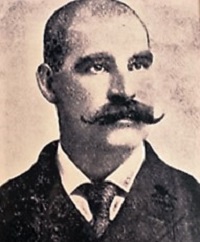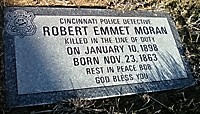Detective Robert Emmet Moran | Cincinnati Police Division

Age: 35
Served: 7 years
February 1, 1891 to January 10, 1898
OFFICER
Bob was born November 23, 1863 in Bellefontaine, Ohio, the fourth child born to Irish immigrants, William J. and Margaret T. (O’Rourke) Moran. William and his four brothers were horse dealers, plying their trade in different parts of the country. Before 1870, William, Nicholas, and Thomas partnered up in a Cincinnati venture at 26 W. 5th Street and Langdon Alley. The partnership did not fare well, but after his two brothers left for other regions, William’s business flourished. By 1875, the family was living at 206 Sycamore, across the street from St. Xaxier Church. Bob was only eleven years old, but it was conceded by all who knew them that he was his father’s confidant and heir apparent. That all came crushing down on August 19, 1875.
By the time Nicholas and Thomas came back to Cincinnati, William had had a judgment against them for company funds they had removed. When they returned with several horses and a mule, the Sheriff impounded the mule against the debt. The brothers were enraged, confronted William at his stables, and in front of Bob, beat and kicked him to death.
William left his wife and five children. William Jr., a 16-year-old law student, became the man of the family and took a job as a clerk. The family had to move to 307 Walnut Street as boarders. A couple of years later, Bob also took a job as a clerk in a fish market. By 1883, the family moved back to 206 Sycamore Street.
Bob married Anna Summe on June 23, 1884. He joined the Cincinnati Police Department on January 24, 1891 as a Substitute Patrolman. Normally, this was a probationary position from which one was promoted to regular patrolman when the candidate was considered capable and a vacancy existed – usually 6 to 18 months. Robert was promoted in 3 months on March 17, 1891.
By January 1895, Patrolman Moran was well established on his beat at 6th and Vine Streets. During his few years, he had done some great detective work and his work came to the notice of Police Chief Phillip Deitsch. On September 18, 1896, he was appointed a detailed detective at headquarters. Chief Deitsch described him as, “an efficient and able officer and his work in the Central District has been a matter of favorable comment from his superior officers on several occasions.” Within a month, and several more times in the next 13 months, Detective Moran was in the newspapers making arrests, including several involving armed career felons. He moved his family to 1488 State Street and Anna was pregnant for a 5th time.
INCIDENT
During the Christmas holidays of 1897, bandits entered the Wiederman’s Jewelry Store at 1602 Freeman Avenue, bound and gagged the clerk, and made off with property. After several days and nights, detectives traced some of the jewelry to a home on Walnut Street near Mercer. Detectives James Dwyer and Lou Becker found Herman Diehm, alias Ed Meyers, and Eddy Bowers, members of the “West End Gang” coming from the residence and attempted to arrest them. Bowers was captured, but Diehm “fought like a tiger” and escaped.
On January 9, 1898, a man advised Detectives Moran and Phil Roach that Diehm was at Jack Dougherty’s house at 547 E. 8th Street with others of the gang and possibly some of the loot. The man warned the detectives that he would not be captured without a desperate fight. The officers notified Night Chief Hehemann when he came on duty at 8 o’clock. He detailed Detectives Roach, Becker, Dwyer, and Moran to go arrest Diehm. Detective Dwyer telephoned the Hammond Street Station and Lieutenant Kane sent Sergeant Jim Sinkking and Officers Miller, Parr, and Gheogan to assist.
A plan was devised, and the officers reminded each other that Diehm would rather kill than be taken alive. Sergeant Sinkking and the uniformed patrolmen went to the rear of the house on Dublin Street. Detectives Becker and Roach went to a side door and Detectives Moran and Dwyer to the front door. As they approached the front door, they heard low talking inside, and it was apparent that those inside knew of their presence.
Detective Moran told Dwyer, “Stand aside, Jim, he knows you.” Detective Moran knocked, the front door opened slightly, and three shots were fired from inside in quick succession. One bullet passed through Detective Moran’s torso. Another hit his watch chain and ricocheted away without taking effect. He staggered backwards, fired two shots through the door, and fell into the arms of Detective Dwyer saying, “My God, Jim, I’m shot! Send me to the hospital!”
Upon hearing the shots, Roach and Becker ran to the front door. They and Dwyer carried Detective Moran down to Lock Street and placed him in Patrol 2 which took him to Cincinnati General Hospital. Diehm escaped out the side door.
Detectives Roach and Becker, with four patrolmen, entered the house and arrested John Hattersly (26) of 6 Perin Street, Buck Wainright (26) of 932 Kenyon Avenue, and Johnny Needham (25) of 825 West Liberty Street, and took them to the Hammond Street Stationhouse.
At the Hammond Street Station, Needham conceded that he saw Diehm fire some shots, but did not see who he shot. By 12:30 a.m., a warrant for Shooting to Kill was filed against Diehm. The detectives and several officers searched for Diehm through the night, to no avail.
DEATH
At the hospital, Assistant Police Surgeon James M. French and Doctor N. P. Dandridge removed a .41 caliber bullet which had pierced both of Detective Moran’s lungs. He rested easily to 7 a.m. the next day, January 10, 1898, but then took a turn for the worst. Mrs. Moran, though several months pregnant, came to the hospital where she cared for his every need. Deputy Clerk of Police Court, Edward McHugh, took a dying declaration in the presence of Lieutenant Krumpe and Dr. J. M. French. He made another in the presence of J.B. Menke, Al Wuest, and Peter J. O’Hara. Each time he identified Diehm as the man who shot him. Reverend James Donohue of St. Edwards Church administered the sacrament of Extreme Unction. Detective Moran died at 1:10 p.m.
Detective Moran left his pregnant wife, Anna, and four children; Edward G. Moran (11), Robert Moran (7), Elmer Moran (4), and Florence Moran (2). He was laid out in his home at 1488 State Street. Father F. X. Dutton presided over the funeral, a high mass at the Blessed Sacrament Church on Wilder Avenue near Gest Street and was entombed at St. Joseph (New) Cemetery. Lieutenant Krumpe, Sergeant Keidel, Detectives Phillip J. Roach, and James Dwyer, and Officers John H. Martin, James O’Neill, and Michael Batters acted as pallbearers. Due to frozen ground, his actual burial in Section 1, Lot 17, Division C occurred on April 5, 1898.
INVESTIGATION
On the evening of January 10, three boys who knew Diehm well notified police that they had seen him at the foot of Poplar Street with his accomplice in a burglar, Henry Stadtfeldt, and that they exchanged revolvers. Diehm remarked to Stadtfeldt that he would not be taken alive.
Based on a flier distributed to area law enforcement agencies by Chief Phillip Deitsch, on the evening of January 11, Covington Officers discovered Diehm in their city. Covington Lieutenant Schleuter and Officers Kiely and Brenkamp followed him to the Central Hotel on Pike Street near Russell Street. At 1 a.m. on January 12, they crashed through the door and arrested Diehm in bed. He had a .38 caliber British Bulldog revolver under his pillow. Diehm made a point that he had fired that particular revolver the night that Detective Moran was shot, but claimed it was only in self-defense.
Stadtfeldt was finally located in Chicago, with a revolver, and extradited to Cincinnati on March 1, 1898, but the revolver he was arrested with was not the one that was used in Detective Moran’s murder.
Diehm was indicted for Murder of the 1st Degree. Jury selection began on April 25, 1898, Judge Samuel Smith, presiding. Diehm’s attorneys argued that Diehm fired, but that he had missed Detective Moran, that he didn’t have a .41 caliber revolver, and therefore someone else shot him. During the trial, several persons, including wives of those arrested, claimed that they never saw Diehm, or anyone else, fire revolvers from inside and claimed that the shooter must have been outside. To the shock of all, after only 5 hours of deliberation, on May 14, 1898, the jury returned a verdict of Not Guilty. The prosecution, so certain of a conviction, had given Diehm immunity on the Burglary charge to get his deposition regarding Stadtfeldt, so he could not be charged with that either.
EPILOGUE
Within ten days, an emboldened Diehm, back with the West End Gang and now calling themselves the Dirty Dozen, made it known to officers that they were well armed and would shoot any officer trying to arrest them. On the next night, police arrested 2 of the gang for Loitering. Diehm, now less emboldened, decided to leave town and, before doing so, burglarized a residence and stole some diamonds. He was soon captured in Chicago and brought back to Cincinnati. On the same night, another of the Dirty Dozen was arrested for pointing a firearm at Patrolman Slattery. The Dirty Dozen seems to have dissolved after these arrests. Diehm was in and out of prison several times for offenses in several states until finally convicted of a murder in Chicago in 1912.
On March 9, 1898, Anna gave birth to Detective Moran’s fifth child, a boy she named Emmett Joseph, but he died later that year on December 29, 1898.
By 1900, Mrs. Moran and her 4 remaining children had moved in with her parents and they lived on First Avenue in Price Hill. After her parents died, she moved to Liberty Street near Freeman and passed away 52 years after her husband in 1940.
His other children survived and had children of their own. Almost exactly 60 years after Detective Moran joined the Police Department, his grandson, Stanley Grothaus, joined in 1951 and rose to the level of Assistant Police Chief prior to retiring in 1978, 80 years after his death. Detective Moran’s great grandson, William M. Gustavson, served over the Police Division as Safety Director from 1992 through 1996.


During June 2009, Greater Cincinnati Police Historical Society Vice President and Volunteer, Thomas and Marilou Waller, noted that Detective Moran’s gravestone substantially sunk into the ground. They asked for the family’s permission to repair the grave. The family not only approved, but Great Grandson Glenn Grothaus purchased a replacement headstone that identified Moran as a detective killed in the line of duty.
If you know of information, artifacts, artifacts, or images regarding this officer or incident, please contact the Greater Cincinnati Police Museum at Memorial@Police-Museum.org.
© This narrative was researched and revised on January 18, 2016 by Cincinnati Police Lieutenant Stephen R. Kramer (Retired), Greater Cincinnati Police Historical Society President. All rights are reserved to him and the Greater Cincinnati Police Museum.